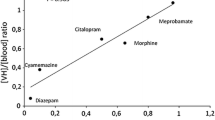Abstract
Bone marrow (BM) analysis is of forensic interest for postmortem toxicological investigations where blood samples are unavailable or unusable. Due to the lack of studies, it remains difficult to interpret concentrations of xenobiotics measured in this matrix. Based on a statistical approach published previously to interpret meprobamate concentrations in bile and vitreous humor, we propose here a diagnostic test for interpretation of BM meprobamate concentrations from analysis of 99 sets of autopsy data. The mean age was 48 years (range 18–80 years, one unknown) for males and 50 years (range 19–80 years, one unknown) for females, with a male/female ratio at 0.768. A BM concentration threshold of 11.3 μg/g was found to be statistically equivalent to that of a blood meprobamate concentration threshold of 50 μg/ml in distinguishing overdose from therapeutic use. The intrinsic qualities of this diagnostic test were good with sensitivity of 0.82 and specificity of 0.92. Compared to previous tests published with the same objective on vitreous humor and bile, this study shows that BM is a useful alternative matrix to reveal meprobamate overdose when blood, vitreous humor, and bile are not available or unusable.



Similar content being viewed by others
References
Cartiser N, Bevalot F, Fanton L, Gaillard Y, Guitton J (2011) State-of-the-art of bone marrow analysis in forensic toxicology: a review. Int J Legal Med 125(2):181–198. doi:10.1007/s00414-010-0525-6
Winek CL, Janssen JK (1982) Blood versus bone marrow isopropanol concentrations in rabbits. Forensic Sci Int 20(1):11–20
Winek CL, Susa D (1982) Blood versus bone marrow methanol concentrations in rabbits. Forensic Sci Int 19(2):165–175. doi:0379-0738(82)90042-1
Winek CL, Costantino AG, Wahba WW, Collom WD (1985) Blood versus bone marrow pentobarbital concentrations. Forensic Sci Int 27(1):15–24
Winek CL, Westwood SE, Wahba WW (1990) Plasma versus bone marrow desipramine: a comparative study. Forensic Sci Int 48(1):49–57
Maeda H, Oritani S, Nagai K, Tanaka T, Tanaka N (1997) Detection of bromisovalum from the bone marrow of skeletonized human remains: a case report with a comparison between gas chromatography/mass spectrometry (GC/MS) and high-performance liquid chromatography/mass spectrometry (LC/MS). Med Sci Law 37(3):248–253
Kojima T, Okamoto I, Miyazaki T, Chikasue F, Yashiki M, Nakamura K (1986) Detection of methamphetamine and amphetamine in a skeletonized body buried for 5 years. Forensic Sci Int 31(2):93–102. doi:0379-0738(86)90193-3
Bal TS, Hewitt RW, Hiscutt AA, Johnson B (1989) Analysis of bone marrow and decomposed body tissue for the presence of paracetamol and dextropropoxyphene. J Forensic Sci Soc 29(3):219–223
Noguchi TT, Nakamura GR, Griesemer EC (1978) Drug analyses of skeletonizing remains. J Forensic Sci 23(3):490–492
Kudo K, Sugie H, Syoui N, Kurihara K, Jitsufuchi N, Imamura T, Ikeda N (1997) Detection of triazolam in skeletal remains buried for 4 years. Int J Legal Med 110(5):281–283
Higuchi T, Kogawa H, Satoh M, Tatsuno M, Tsuchihashi H (1996) Application of high-performance liquid chromatography/mass spectrometry to drug screening. Am J Forensic Med Pathol 17(1):21–23
McIntyre LM, King CV, Boratto M, Drummer OH (2000) Post-mortem drug analyses in bone and bone marrow. Ther Drug Monit 22(1):79–83
Cartiser N, Bevalot F, Chatenay C, Le Meur C, Gaillard Y, Malicier D, Guitton J, Fanton L (2011) Postmortem measurement of caffeine in bone marrow: influence of sample location and correlation with blood concentration. Forensic Sci Int 210(1–3):149–153. doi:S0379-0738(11)00114-9
Fanton L, Bevalot F, Gustin MP, Paultre CZ, Le Meur C, Malicier D (2009) Interpretation of drug concentrations in an alternative matrix: the case of meprobamate in bile. Int J Legal Med 123(2):97–102. doi:10.1007/s00414-008-0259-x
Bevalot F, Gustin MP, Cartiser N, Le Meur C, Malicier D, Fanton L (2011) Interpretation of drug concentrations in an alternative matrix: the case of meprobamate in vitreous humor. Int J Legal Med 125(3):463–468. doi:10.1007/s00414-011-0560-y
Removal of meprobamate from French market. http://ansm.sante.fr/S-informer/Informations-de-securite-Retraits-de-lots-et-de-produits/Specialites-contenant-du-meprobamate-seul-voie-orale-Retrait-du-marche/(language)/fre-FR. Accessed Jan 2013
Prouty RW, Anderson WH (1990) The forensic science implications of site and temporal influences on postmortem blood-drug concentrations. J Forensic Sci 35(2):243–270
Hoizey G, Gozalo C, Canas F, Fornes P, Binet L, Al T, Oget O, Millart H, Lamiable D (2008) Distribution tissulaire post-mortem du méprobamate: à propos de 8 cas. Ann Toxicol Anal 20(1):47–51
Flanagan RJ (1998) Guidelines for the interpretation of analytical toxicology results and unit of measurement conversion factors. Ann Clin Biochem 35(Pt 2):261–267
TIAFT reference blood level list of therapeutic and toxic substances (2005) http://www.tiaft.org/. Accessed July 2007
Gaillard Y, Billault F, Pepin G (1997) Meprobamate overdosage: a continuing problem. Sensitive GC-MS quantitation after solid phase extraction in 19 fatal cases. Forensic Sci Int 86(3):173–180. doi:S0379073897021282
S. Jickells, A Negrusz (eds) (2008) Clarke’s analytical forensic toxicology. Pharmaceutical, London
Takatori T, Tomii S, Terazawa K, Nagao M, Kanamori M, Tomaru Y (1991) A comparative study of diazepam levels in bone marrow versus serum, saliva and brain tissue. Int J Legal Med 104(4):185–188
Watterson JH, Botman JE (2009) Detection of acute diazepam exposure in bone and marrow: influence of tissue type and the dose-death interval on sensitivity of detection by ELISA with liquid chromatography tandem mass spectrometry confirmation. J Forensic Sci 54(3):708–714. doi:10.1111/j.1556-4029.2009.00998.x
The Open Data Drug and Drug Target Database. http://www.drugbank.ca/ Accessed 04 Sept 2012
Acknowledgments
The authors are grateful to Marie Barbier and Lise Magné for their technical assistance.
Author information
Authors and Affiliations
Corresponding author
Rights and permissions
About this article
Cite this article
Bévalot, F., Gustin, M.P., Cartiser, N. et al. Using bone marrow matrix to analyze meprobamate for forensic toxicological purposes. Int J Legal Med 127, 915–921 (2013). https://doi.org/10.1007/s00414-013-0833-8
Received:
Accepted:
Published:
Issue Date:
DOI: https://doi.org/10.1007/s00414-013-0833-8



